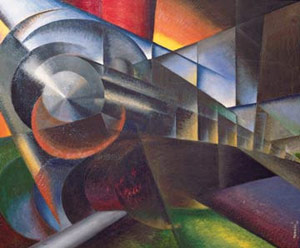
| HOME |
| NERVE |
| REVIEWS |
| ARCHIVE |
| EVENTS |
| LINKS |
| ABOUT US |
| CONTRIBUTORS |
| BACK ISSUES |
| CONTACT US |
 Art in
the Age of Steam
Art in
the Age of Steam
Walker Art Gallery
18th April - 10th August 2008
Reviewed by Sandra Gibson
Impressively compact, this collection succeeds in examining the age of steam from a variety of angles, and the enduring impression it gives of this phase of the Industrial Revolution is of immense optimism. From the careful machine drawings and the photographic celebration of pristine machinery to the portrayal of Man against the geological might of Nature, to the rainbow-held idyll of train in harmony with beautiful landscape. These are images of heroic endeavour, endurance and revolutionary movement - in more senses than one - capturing that sense of pioneering progress that in its scope and speed obliterates the human aspects of dispossession, exploitation, poverty and squalor that were the other facets of industrialisation.
This is not to say that these elements are not represented here, notably in Honore Daumier’s observations of the class structure in travel, or Joaquin Sorolla Y Bastida’s painting of the desperate young woman whose temporary prison is a railway carriage, or the frightened and pathetically young boy who is off by train to the port to seek his fortune abroad, or the poverty-wretched women left behind on the platform whilst their men are embarking on economic emigration. Nor does the exhibition ignore the dangerous, alarming aspect of change allegorised in David Cox’s The Night Train [1849] by horses fleeing the approach of the iron horse. However, these artworks do nothing to undermine the overwhelming sense of belief in a new age of possibility. From the perspective of the space age it is impossible to comprehend the excitement and fear generated by the invention of the locomotive and the possibility of travelling at forty three miles per hour but it was the Victorian equivalent of the space ship and had a far greater social and economic impact than space travel has had on our own age.
Of particular local interest are the references to the Liverpool and Manchester Railway. Thirty miles long, this pioneering piece of railway was opened in 1830. The earliest references were documentary and curiously naïve. Two 1833 prints, Travelling on the Liverpool and Manchester Railway - showing first and second class modes of travel - have a static, illustrative charm that explains their popular appeal. Thomas Talbot Bury’s aquatints of the same railway were released at the same time, but here the emphasis is on the triumph of engineering rather than motive power - also illustrated in Henry Pyall’s Excavation of Olive Mount Four Miles from Liverpool [1831].
Artists such as William Powell Frith, Karl Karger and Abraham Solomon continued using conventional narrative realism to portray the social drama of rail travel, but it takes the work of Chirico to convey the emotional landscape of the railway station with its meetings and departures and strange potential for dread. Other artists were aware that from the viewpoint of artistic technique the railway age presented new challenges in expressing a sense of movement at speed, in showing the combined effects of fire and steam and smoke and light and weather. No-one did this better than Turner. No-one. Turner’s work makes Monet look tired and tawdry by comparison. Ironically, Turner is only represented through the flat screen; his work Rain, Steam and Speed – The Great Western Railway [1844] which starts the exhibition being considered too fragile to travel!
I haven’t even mentioned nostalgia. Suffice it to say, men of a certain age and demeanour had a rapt look on their faces as they went round the exhibition for the sixth time that afternoon. You can smell the warm dust from the rough-textured upholstery and feel the leather strap sliding through your hand as you open the door to Eric Ravilious’ surrealistic Train Landscape [1940] and film clips include The Railway Children and Brief Encounter and Night Mail. Most poignant of all are the flickering, ethereal images of the trains of yesteryear riding the rooflines of our Edwardian ancestors.
This exhibition of paintings, lithographs, photographs and film is co-organised by the Walker Art Gallery and the Nelson-Atkins Art Museum in Kansas City. That it is held in the city of the world’s first fully-fledged commercial passenger and freight line is entirely appropriate and the event is the Walker Art Gallery’s main contribution to the Liverpool European Capital of Culture celebrations.
I know this is a cliché but there really is something here for everyone.
Comments:
Comment left by Geoff Edwards on 13th June, 2008 at 20:45
An excellent review of an excellent exhibition. Many congratulations to the curators of this magnificent offering. Thank you to the Walker. Please visit and maybe travel by train (after all its so close to Lime Street!)? It was a great pity that the Turner was unable to travel from London (even by train!).